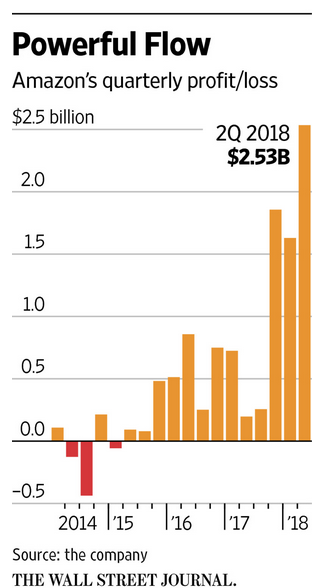A few comments about Amazon’s earnings report
As I made clear in Wednesday’s post on technology, media and telecom, I see Amazon and Google as clear winners in the Internet space. The Internet is the nexus of TMT convergence. And to be successful as this convergence happens, companies need to be positioned more broadly. Facebook and Netflix fail on that score. Apple also has challenges there. But I believe it could buy its way into some markets if it makes the adjustment quickly.
Amazon’s earnings
 Amazon’s numbers had no obvious weak spots. Revenue scale and growth were great as net revenue rose 39% to $52.89 billion from $37.96 billion a year earlier. And Amazon is starting to translate cash flow into net income as growth capex declines in importance; net income rose to $2.53 billion, or $5.07 per share, from $197 million, or 40 cents per share, a year earlier.
Amazon’s numbers had no obvious weak spots. Revenue scale and growth were great as net revenue rose 39% to $52.89 billion from $37.96 billion a year earlier. And Amazon is starting to translate cash flow into net income as growth capex declines in importance; net income rose to $2.53 billion, or $5.07 per share, from $197 million, or 40 cents per share, a year earlier.
Look at the Wall Street Journal’s chart on this (to the left). For the past four years, Amazon has been more profitable. But it’s only been the last three quarters since Amazon has begun to really show bigger net income numbers.
Last year, for instance, Amazon’s cash flow statement showed $18.4 billion in cash flow from operations. But because it used $27.8 billion to plow back into the company, it had to rely on a $9.9 billion slug of cash flow from financing activities to add to its overall cash pile.
But Q2 saw Amazon use only $2.69 billion for investment versus $5.27 in the year-ago quarter. That’s where the supplemental net income is coming from.
But if you look at Amazon’s quarter annualized, you still get an earnings multiple of 90 times. That’s enormous. Amazon would have to earn three times as much in net income to justify its valuation at a more reasonable market multiple. So clearly investors expect more of what we see in this report to pay for Amazon at its current share price.
Where Amazon is doing well
Digging a bit deeper into the report, where Amazon is doing much better than Facebook is in the breadth and depth of its vertical penetration. Here are a few stats:
- In its namesake site, more than half, 53%, of sales were from independent sellers, meaning Amazon is now more of a marketplace destination than a seller itself. This is in sharp contrast to brick and mortar retail competitors trying to match Amazon online.
- The Whole Foods acquisition means that Amazon reported $4.31 billion in revenue from brick-and-mortar stores. And from a distribution perspective, the availability of those physical stores is going to be a big driver of growth in next-day and same-day online sales.
- Amazon Web Services is a big profit driver for Amazon because of the higher margins than the retail business. Revenue there grew 49% to $6.1 billion, helping to lift the overall operating profit margin to 5.6%
- More than 100 million Amazon users are Amazon Prime members. And as Amazon has just raised the price of its Prime membership from $99 to $119 annually, that’s $1.2 billion of revenue.
- Amazon is increasingly moving into advertising. The “other” line item on its income statement, which is mostly ad sales, increased 132% to $2.19 billion from the year-ago quarter.
As the TMT space consolidates, I would like to see Amazon more on the content delivery side of media than on the content creation side, which is expensive. In Amazon’s earnings release it touted the fact that Amazon Prime Video received 22 Emmy Nominations and that it has a partnership with the NFL. But I suspect that a live TV offering would increase margins in that business vertical. I am waiting for Apple and Amazon both to enter that market.
Final thoughts
The big problem with Amazon is valuation. It’s hard to justify paying 90x this quarter’s earnings for a company that is as mature as Amazon is, irrespective of the top-line growth. Amazon’s growth potential is threatened, at a minimum by regulatory challenges in the US and the EU. And likely a lot of incremental income growth has to come from slower capital expenditure and increasing margins.
Having aid that, I think Amazon is as well-positioned for this next phase of technology consolidation as anyone except maybe Google. On the telco/cable side Verizon looks like the best-positioned player to me. The advent of ubiquitous mobile high speed Internet will be a game changer. When that occurs in the next few years, that’s when we will get a big shakeout.
Comments are closed.